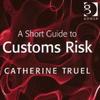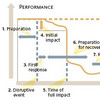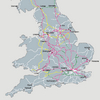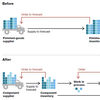 International trade and global supply chains are filled with goods that are criss-crossing the globe and international borders many times on their way from the supplier to the end customer. Customs is perhaps the most important element that facilitates these cross-border movements, and for businesses, failing to comply with customs requirements may result in delayed shipments and serious disruptions in the supply chain. That is why managing customs risk is an integral part of managing global supply chain risks, but customs risks are unfortunately absent from much of the supply chain risk literature. A Short Guide to Customs Risk by Catherine Truel deals exclusively with this topic and after reviewing it I think that it should be required reading for anyone dealing with supply chain risk. That said, customs risk is perhaps more of a logistics risk than a supply chain risk.
International trade and global supply chains are filled with goods that are criss-crossing the globe and international borders many times on their way from the supplier to the end customer. Customs is perhaps the most important element that facilitates these cross-border movements, and for businesses, failing to comply with customs requirements may result in delayed shipments and serious disruptions in the supply chain. That is why managing customs risk is an integral part of managing global supply chain risks, but customs risks are unfortunately absent from much of the supply chain risk literature. A Short Guide to Customs Risk by Catherine Truel deals exclusively with this topic and after reviewing it I think that it should be required reading for anyone dealing with supply chain risk. That said, customs risk is perhaps more of a logistics risk than a supply chain risk.
Business Risks
A Short Guide to Customs Risk is my third review of the books in the Gower Short Guides to Business Risk series. The series covers topics such as reputation risk, political risk, fraud risk, ethical risk, procurement risk and customs risk, and with more topics on the bedding: operational risk, compliance risk, kidnap and ransom risk, corruption risk, equality risk and how to facilitate risk management. Since most of them tie in very nicely with supply chain risk, my reviews of the books in the Gower Short Guides to Business Risk series will be a regular feature on this blog for the weeks to come, already having completed reputation risk and procurement risk.
Customs before and now
Previously, customs processing meant that customs would meticulously check goods and documents before releasing a shipment to the trader. Now, customs processing means site visits, where customs officers check whether businesses comply with customs documentation requirements or not. The switch to such audit based controls has transferred a high level of responsibility and risk to the trader, and it is now the duty of the trader to identify and report any error or irregularity and to keep an impeccable audit trail from initial quotation to receipt of payment. That is not an easy task, and this book shows what customs risks are, how to achieve the necessary compliance with customs regulations and how this can turn into a competitive advantage.
Customs risk and the business
The first chapter illustrates how the different business functions contribute to customs risk in different ways, and that customs risk may appear where you least expect them:
Management
The lack of interest from senior management is the most common source of customs risk, particularly because customs risk, e.g. important changes in regulations or trade agreements, is not usually on the radar of senior executives. Strategic management decisions may also cause the risk to increase, e.g. when buying or selling abroad, when choosing which international trade partners and /or customs brokers to liaise with. Managing strategic customs risk means to look ahead 1-5 years or even more in order to anticipate regulative changes that are yet to come, something top managers rarely do, since other business risks are much more likely to be on their immediate agenda.
Finance
While the Finance department may not be the greatest source of customs risk, it is perhaps nonetheless the department where customs risk may have the greatest affect, especially during a customs audit, which may scrutinize accounts and transactions, invoices, shipping documents and duty payments, inventory values, customs values and invoice values, in order to ensure that the information declared at clearance accurately matches the account transactions.
Procurement
Depending on the choice of sourcing country, this business function is likely to deal with customs risk on an almost daily basis. Trade agreements between different countries or other legal requirements imposed by the government to protect domestic manufacturers may require detailed product accounting to comply with rules of origin. Security and traceability requirements may add additional burdens. Ensuring customs compliance will be an important part of supplier relationship management for the Procurement department. Misunderstanding International Commerce Terms (Incoterms) such as ExWork, FOB or CIF is a common source of customs risk in procurement, because the customs responsibility usually lies with the importer.
Sales and customer service
A given trade agreement may require export orders with reduced import duties to be shipped directly, without the possibility of optimizing or consolidating shipments, as one would do in “normal” sales. Export sales may also be hampered by trade agreements that involve quotas or anti-dumping duties. Certain products may also be subject to export controls or restrictions that may change from the time of sale to the time of shipment, for the better or for the worse. International sales are wrought with traps and pitfalls imposing extra costs if the full extent of customs regulations is not known to the businesses involved.
Manufacturing, repair and service
Cross-border movements for repair, return, calibration, refill or product recall must use the correct customs procedures to ensure that these transactions are smooth, timely and duty free. Contracts including installation abroad often involve that products, parts and equipment cross borders several times. More often than not these shipments for maintenance and repair are urgent emergency orders that are arranged in a hurry, and if customs procedures are unclear or if service warranties and responsibilities for customs processing are unclear, this may incur unforeseen customs duties, particularly if – as it often happens – some last-minute items are thrown in undeclared with the rest of the consignment.
Logistics
Logistics is faced with all sorts of customs risks, as it is the function that physically moves goods across borders, and therefore must make sure that all documentation complies with the requirements. Logistics is the function that also ensures the security and safety of the physical flow of goods, e.g. secure warehouses or loading/unloading points where goods is transferred en route. Customs risk is essentially a logistics risk. While it is obviously imperative for the logistics provider to select the best means of transportation, it is also imperative to keep an accurate record and customs-compliant documents at all times, and this also includes sub-contractors, local carriers and agents, who may not always be as compliant as the logistics provider with whom the business has a contract with, and who can be a source of customs risk.
Information technology
The IT department manages the tools that collect , process, file and report the information used for customs management. Tariff codes and duties in particular are time sensitive data as they are regularly updated. An outdated information systems or a system that can not (or can not easily) provide customs-compliant information can be a major source of customs risk.
These are just some of the business functions that can be a source of customs risk. There are indeed many more and this book deals with most if not all of them.
Customs Risk and Customs Authorities
Chapter Two explains the role of customs authorities, how they operate, how they assess consignments, how they assess “risky” consignments, and what businesses can do to avert this risk, simply by being more customs-compliant in their documentation and internal procedures.
Classification
Chapter Three deals with classification, and how important it is to describe the same product in the same way in different languages across the world. Essentially, this chapter describes the Harmonized Commodity Description and Coding System, or Harmonized System in short, whereby all conceivable goods are precisely described using a six-digit code. Since similar but differently coded products may have very different customs tariffs it is important to find the correct code. Classification be a source of risk as well as an opportunity. A wrong classification is a misinterpretation of the product, which could be due to a genuine error, a wrong interpretation of the code, or an intention to hide the true nature of a product. In any case, this will most certainly lead to further scrutiny of the company’s products or customs records, potentially causing delays and disruptions in the supply chain. Accurate classification gives instant visibility of how product may be treated by customs in different countries and what duty rates, restrictions and prohibitions that may exist. Accurate classification speeds up the customs process, and accurate classification may lead to reduced rates, if ,say, the company realizes that by slightly altering a product designed for export it may be subject to significantly reduced tariff rates compared to the same product designed for the domestic market.
Valuation
Chapter Four looks at valuation. Valuation is the process used to calculate the value of a goods for customs purposes. This value is the taxable base upon which duties and taxes are levied. Consequently, valuation is an important area for customs, since the taxable base is critical to their revenue collection. As with Classification, over-valuing or under-valuing a goods will usually backfire, eventually, and chapter Four describes the six methods of valuation usually applied by customs authorities worldwide.
Rules of Origin and Trade Agreements
Trade agreements between countries often result in reduced duty rates or even nil duties for certain goods. This may tempt companies to ship their goods to one of these countries and export these from there under the rules of origin, although they are not entitled to so. Chapter Five describes the different methods that are used to determine origin or a combination of origin and how these methods can be a source of risk as well as an opportunity, e.g. cumulation, diagonal cumulation, full cumulation, tolerance or de minimis, and duty drawback.
Customs Procedures
Chapter Six details different customs procedures, and how a trader should select the correct procedure that matches the purpose of the transaction, e.g. inward processing, outward processing, customs warehousing, drawback, temporary admission, home use or end use. Some procedures may present risks, while others if used advantageously, may come as opportunities.
Security
Although supply chain security has always been a part of international trade, the evnts of 9/11 changed the priorities from revenue collection to border protection and the prevention of illegal and terrorist activities. Chapter Seven describes the security initiatives undertaken by customs authorities to address a number of security issues and how companies need to comply with them.
Conclusion
This book has opened my eyes to a new set of supply chain risks that I have been unaware of : Customs risk. Now, I may have overlooked it in the numerous articles I have read in the three years I have been researching supply chain risk, but seriously, I haven’t come across it as a major risk factor anywhere…so far. Today, looking at some previous articles for my literature reviews, I did find that it appears implicitly as “transit time issues” in Manuj and Mentzer (2008) on global supply chain risk management. A more explicit appearance is in Pfohl, Gallus & Köhler (2008) on logistics risks in Germany, where delays or other formality (“red tape”) issues with customs clearance are cited as the most frequently occurring external risk. Obviously, customs risk exists, but its impacts are not widely known in the supply chain risk community. Until now, perhaps. This book, and my review of it, will hopefully contribute to giving customs risk its rightful place as a supply chain risk that should not be neglected.
Reference
Truel, C. (2010) A Short Guide to Customs Risk. Farnham: Gower Publishing
Author link
- intltradeinstrument.com: Catherine Truel
Publisher link
- gowerpublishing.com: A Short Guide to Customs Risk
- gowerpublishing.com: A Short Guide to Customs Risk (Introduction)
Buy this book
- amazon.com: A Short Guide to Customs Risk
Related posts
- husdal.com: Book Review – Political Risk
- husdal.com: Book Review – Reputation Risk
- husdal.com: Book Review – Procurement Risk












